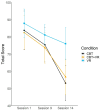Preliminary Study of Efficacy and Safety of Self-Administered Virtual Exposure Therapy for Social Anxiety Disorder vs. Cognitive-Behavioral Therapy
- PMID: 36138972
- PMCID: PMC9496986
- DOI: 10.3390/brainsci12091236
Preliminary Study of Efficacy and Safety of Self-Administered Virtual Exposure Therapy for Social Anxiety Disorder vs. Cognitive-Behavioral Therapy
Abstract
Social anxiety disorder (SAD) is one of the most frequent mental disorders. Exposure to virtual reality can be a solution complementing standard CBT (cognitive-behavioral therapy) or can be used as an independent therapeutic tool. The study's objective was to assess the safety and efficacy of using self-administered virtual reality exposure vs. CBT and CBT with virtual exposure. We assessed the efficacy of the applied intervention with the Leibowitz Social Anxiety Scale (LSAS). We compared three groups: CBT (n = 25), CBT + VR (n = 29), and self-administered therapy without aid of a therapist (n = 19). The results indicated that all three groups showed changes on the LSAS. The simple effect analysis showed that there were no differences between experimental conditions at T0 (session 1) and T1 (session 9) and that the only significant difference occurred at T2 (session 14). The pairwise comparisons showed that the participants in the VR condition scored higher on the LSAS score during the measurement at T2 than participants in CBT condition. Our study has several limitations. The presented initial study shows that the methods of CBT for social anxiety used so far are also effective, while the VR tool for self-therapy requires further research.
Keywords: cognitive-behavioral therapy; exposure; self-administered therapy; social anxiety disorder; virtual reality exposure.
Conflict of interest statement
Paweł Mierzejewski, Przemysław Bieńkowski, Tadeusz Parnowski, Izabela Stefaniak, and Sławomir Murawiec were contractors hired by Tomorrow Sp. z o.o., the grant holder. Krzysztof Hanusz was an employee of Tomorrow Sp. z o.o. (2012–2018) and contractor (2019–2020).
Figures



References
-
- Rabe-Jabłonska J. Fobia społeczna. Rozpowszechnienie, kryteria rozpoznawania, podtypy, przebieg, wspołchorobowość leczenie. Psychiatr. W Prakt. Ogolnolekarskiej. 2002;2:161–166.
-
- Bruce S.E., Yonkers K.A., Otto M.W., Eisen J.L., Weisberg R., Pagano M.E., Shea M.T., Keller M.B. Influence of psychiatric comorbidity on recovery and recurrence in generalised anxiety disorder, social phobia, and panic disorder: A 12-year prospective study. Am. J. Psychiatry. 2005;162:1179–1187. doi: 10.1176/appi.ajp.162.6.1179. - DOI - PMC - PubMed
-
- Otto M.W., Pollack M.H., Maki K.M., Gould R.A., Worthington J.J., 3rd, Smoller J.W., Rosenbaum J.F. Childhood history of anxiety disorders among adults with social phobia: Rates, correlates, and comparisons with patients with panic disorder. Depress. Anxiety. 2001;14:209–213. doi: 10.1002/da.1068. - DOI - PubMed
-
- First M.B., Allen F., Harold A.P. DSM-IV-TR Guideb. American Psychiatric Publishing, Inc.; Wahington, DC, USA: 2004.
Grants and funding
LinkOut - more resources
Full Text Sources

